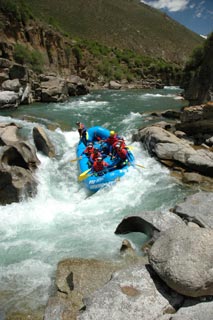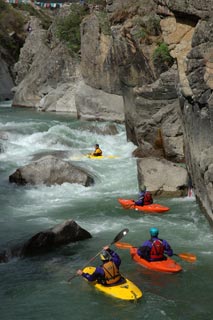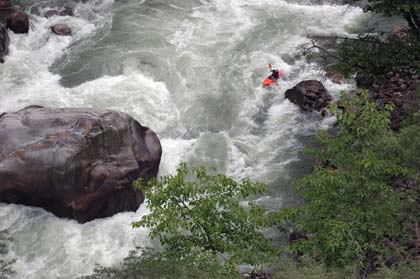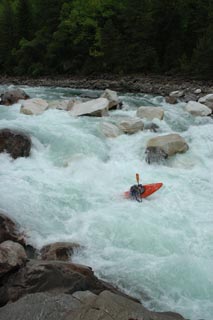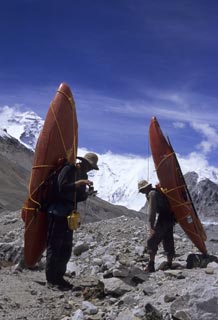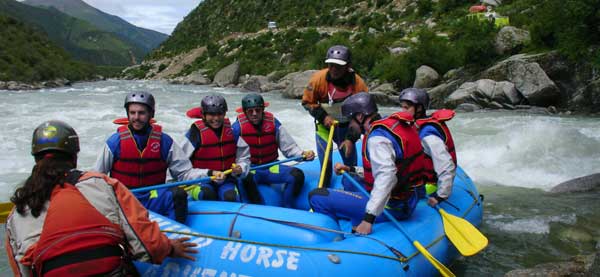Travellers' Tales :: Rafting the Drigung
RAFTING THE DRIGUNG
A wild ride on the Drigung River, central Tibet
Michael Buckley
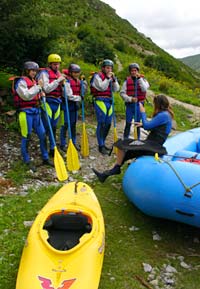
FEELING RATHER ridiculous—decked out in a flashy wetsuit, rubber booties, lifejacket and helmet—I waddle over to the big blue raft. All the gear is in the interests of warmth and waterproofing—and safety. Georgia gives us a briefing on what to do if ejected from the craft (don't try and tie a rescue rope around your neck). Georgia, from Australia, is conducting safety rescue courses for the Tibetan rafting trainees. She's our safety kayaker on this day trip, scouting rapids ahead and trolling for any body that happens to be floating past.
Instructions over, we turn to face the river itself—which is swollen by monsoon rains. Definitely moody—frothy and foaming in parts. No room for error here. From this point on, it's class III and IV rapids—and our lives are in the hands of Captain Ram. Ram is a bearded young Nepalese with long hair tied back in a ponytail, and a warped sense of humour. Happily, Ram has ten years of whitewater rafting and kayaking experience on rivers in Nepal. He gives us a briefing on when to paddle forward, backward, stop, jump to the left side of the boat, jump to the right.
There are not many rivers in the world where you can raft above 4,000 metres. In Tibet, most terrain starts at this elevation, and it's all uphill from there. Many of the sub-continent's mighty rivers—the Indus, Salween, Mekong, Yangtse, and Brahmaputra—are sourced in Tibet, rushing through deep gorges between towering snowcapped peaks (the Yarlung Tsangpo Grand Canyon is the world's deepest). I check my watch: the altitude at the put-in point is 4,080 metres.
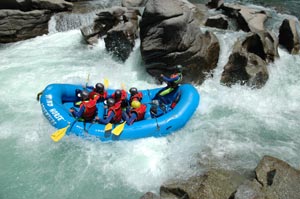
Photo: Chris Jones
We push off into the swirling Drigung Chu, nerves on edge. The majestic landscape flashes by in a blur—not much time to take it in when your energy is concentrated on remaining glued to the raft. But you feel the raw power of the river as no onlooker can. And you begin to realise that rivers are not all that simple—a point emphasised by the menacing waves crashing around your head. Rafters have more specific lingo for them: standing waves, pillow waves, eddies, seams and drops—and deadly 'holes'.
On the river today are two matching blue rafts, both with a Captain Ram at the helm—both from Nepal. Provides a sort of stereo rafting effect for those with altitude-induced illusions. Injected into this is a dose of high spirits created by competitiveness among rafters—broadsiding boats, and drenching occupants by batting paddles on the surface. In the rafts: a couple from Germany, two Swiss guys, a brother and sister from the US, a Dutchman, a Tibetan woman. I have missed most names, but remember the nationalities. Apart from high water, there's a lot of adrenaline floating around. The symphony of first-time rafters: high-pitched yelps, yahooing, and the occasional scream as waves crash over the bows, drenching all in frigid water. A good deal of high-pitched vocalising emanates from Lodol, the young Tibetan woman on board next to me. She's on the lam: everybody at work has been told she's taken a day off to deal with family problems—and lord knows what she has told her family, as they would surely fear for her safety.
I'm trying to figure out if Captain Ram is bent on deliberately steering us into troubled waters at times to increase the excitement. In any case, he's a wizard at reading the river—looking for the best line through the rapids, steering clear of submerged rocks—and 'holes' that can flip a small craft like the spin-cycle of a washing machine (much magnified). Forward! Forward! yells Ram, urgently at one point. That translates as Fast forward! I think. There's no special command for Jump out of your skin!!— which could easily be applied when we reach a spot with barely enough space for the raft to squeeze through. It's a kind of gate formed by rocks, so our raft has to be very precise. But we pull it off. Everybody good? inquires Ram. He calls for a group high-five with upright paddles.
Woman overboard! We have lost the college student from Virginia, along with the Dutchman—both swept out of the raft by a freak wave. But they are soon back with us, none the worse for wear, though somewhat shaken. To the rescue is Phuntsok, the Tibetan trainee rafter aboard. In a few more seasons, he should be able to take over the helm from experienced rafters like Ram.
In fact, after Captain Ram goes overboard, this is what Phuntsok does. Captain Ram has jumped onto the other raft to wrestle a Tibetan trainee who has obviously slurred his reputation. Phuntsok's voice is not as booming as Ram's, but he's confident on directions. Tibetan trainees have to overcome cultural taboos about fast-flowing rivers—normally places to stay well away from because they are associated with drowning. There is no tradition of pleasure boating. Tibetans don't spend any time on rivers, they don't fish, and the boatmen who ply traditional yak-skin coracles at river crossings are looked down upon.
In calmer waters, time to relax on the paddle and take in the scenery. And wave at Tibetans lining the banks. Some wave back, others just stare, open-mouthed. Foreigners are alien enough, but ones dressed in coloured wetsuits and helmets must surely appear quite bizarre. When we park at the riverside for a lunch stop, curious Tibetans edge closer—not so shy. Which poses a rather embarrassing problem for the young man from Switzerland, who has a bad stomach. We wish him luck as he runs behind a low rock wall, because apart from curious children, he has to deal with the logistics of removing half a dozen layers of gear and a wetsuit. Mission impossible? Well, he duly returns, looking considerably relieved.
After lunch, we resume the rafting descent: more bouts of being heaved around and showered in freezing water. This alternates with more tranquil stretches where I even indulge in bird spotting: I sight a hoopoe, an exotic-looking bird with spiky orange crest and black-and-white wings. And all too soon, the wild ride comes to an end. The gear is stowed away. The rafts are deflated, rolled up and packed onto a minibus. We help ourselves to mugs of hot tea. And I am thinking that while my fingers are numbed from the cold waters, my brain is exceedingly clear and calm. I have survived the ride. Maybe a new form of meditation possible here: focusing on each paddle stroke. Paf! Nonsense, I tell myself—it can probably be all put down to the high altitude, which can create illusions, combined with a fair dose of adrenaline. Whatever the case, the natural high from rafting lasts all the way back to Lhasa—and into the following day.
And something else that lingers: questions about how this extraordinary rafting run came into being. The answers are provided by Chris Jones, project manager for Wind Horse Adventure. Chris Jones and Captain Ram made a first descent of the Drigung River by kayak in 2003. The knowledge gained from that descent led to the first commercial whitewater rafting run soon after.
As part of Wind Horse Adventure, a high-end touring company, Chris Jones and partner Sharyn Smith run the only rafting company in Tibet that offers regular trips from Lhasa. Clients range from first-time rafters to world-class kayakers on exploratory first descents. There's a Canadian connection: Sharyn Smith is from BC, and Chris Jones is a Tasmanian transplanted to BC. Sharyn handles marketing and video production; Chris is the river person—an experienced rafter and kayaker. Quite apart from the commercial operation, Chris has a personal stake in Tibet. 'There's so much to explore here,' he says. 'It's such an amazing place.' He's hooked on the prospect of first descents on class IV and class V+ rapids, having led several expeditions in Tibet. And there are many more rivers to run, he says excitedly.
BEING THERE
The rafting season in Tibet is May to September inclusive. You need a group of four or more to get a rafting trip together, and you need to allow 3 or 4 days in Lhasa to acclimatise to the altitude because of the physical exertion of paddling. For more details, consult the rafting pages of the website: www.windhorsetibet.com.

POSTCARDS FROM GORGE-OUS PLACES
Photos copyright Chris Jones. To view more pictures, go to windhorsetibet.com.
